The Effectiveness of Transversus Abdominis Plane and Quadratus Lumborum Blocks in Acute Postoperative Pain Following Cesarean Section—A Randomized, Single-Blind, Controlled Trial
Abstract
:1. Introduction
2. Material and Methods
2.1. Study Design
2.2. Anesthesia and Regional Block
2.3. Postoperative Pain Assessment
2.4. Statistics
2.5. Power Analysis
2.6. Outcomes
3. Results
3.1. Patient Demographics
3.2. Acute Postoperative Pain
3.3. Antinociceptive Drugs
3.4. Correlation between Pain Intensity and Indications for Cesarean Section
4. Discussion
5. Conclusions
Author Contributions
Funding
Institutional Review Board Statement
Informed Consent Statement
Data Availability Statement
Acknowledgments
Conflicts of Interest
Abbreviations
References
- Boerma, T.; Ronsmans, C.; Melesse, D.Y.; Barros, A.J.D.; Barros, F.C.; Juan, L.; Moller, A.B.; Say, L.; Hosseinpoor, A.R.; Yi, M.; et al. Global epidemiology of use of and disparities in caesarean sections. Lancet 2018, 392, 1341–1348. [Google Scholar] [CrossRef]
- Caesarean sections—Organisation for Economic Co-operation and Development. Available online: https://data.oecd.org/healthcare/caesarean-sections.htm (accessed on 17 May 2021).
- Gerbershagen, H.J.; Aduckathil, S.; van Wijck, A.J.; Peelen, L.M.; Kalkman, C.J.; Meissner, W. Pain intensity on the first day after surgery: A prospective cohort study comparing 179 surgical procedures. Anesthesiology 2013, 118, 934–944. [Google Scholar] [CrossRef] [PubMed] [Green Version]
- Marcus, H.; Gerbershagen, H.J.; Peelen, L.M.; Aduckathil, S.; Kappen, T.H.; Kalkman, C.J.; Meissner, W.; Stamer, U.M. Quality of pain treatment after caesarean section: Results of a multicentre cohort study. Eur. J. Pain 2015, 19, 929–939. [Google Scholar] [CrossRef]
- Hendrickson, R.G.; McKeown, N.J. Is maternal opioid use hazardous to breast-fed infants? Clin. Toxicol. 2012, 50, 1–14. [Google Scholar] [CrossRef] [PubMed]
- Eisenach, J.C.; Pan, P.H.; Smiley, R.; Lavand’homme, P.; Landau, R.; Houle, T.T. Severity of acute pain after childbirth, but not type of delivery, predicts persistent pain and postpartum depression. Pain 2008, 140, 87–94. [Google Scholar] [CrossRef] [PubMed]
- Grace, S.L.; Evindar, A.; Stewart, D.E. The effect of postpartum depression on child cognitive development and behavior: A review and critical analysis of the literature. Arch. Womens Ment. Health 2003, 6, 263–274. [Google Scholar] [CrossRef] [PubMed]
- Evans, S.; Keenan, T.R.; Shipton, E.A. Psychosocial adjustment and physical health of children living with maternal chronic pain. J. Paediatr. Child. Health 2007, 43, 262–270. [Google Scholar] [CrossRef] [PubMed]
- Champaneria, R.; Shah, L.; Wilson, M.; Daniels, J. Clinical effectiveness of transversus abdominis plane (TAP) blocks for pain relief after caesarean section: A meta-analysis. Int. J. Obstet. Anesth. 2016, 28, 45–60. [Google Scholar] [CrossRef]
- Blanco, R.; Ansari, T.; Girgis, E. Quadratus lumborum block for postoperative pain after caesarean section: A randomised controlled trial. Eur. J. Anaesthesiol. 2015, 32, 812–818. [Google Scholar] [CrossRef]
- Blanco, R.; Ansari, T.; Riad, W.; Shetty, N. Quadratus Lumborum Block Versus Transversus Abdominis Plane Block for Postoperative Pain After Cesarean Delivery: A Randomized Controlled Trial. Reg. Anesth. Pain Med. 2016, 41, 757–762. [Google Scholar] [CrossRef]
- El-Boghdadly, K.; Desai, N.; Halpern, S.; Blake, L.; Odor, P.M.; Bampoe, S.; Carvalho, B.; Sultan, P. Quadratus lumborum block vs. transversus abdominis plane block for caesarean delivery: A systematic review and network meta-analysis *. Anaesthesia 2021, 76, 393–403. [Google Scholar] [CrossRef]
- Kwikiriza, A.; Kiwanuka, J.K.; Firth, P.G.; Hoeft, M.A.; Modest, V.E.; Ttendo, S.S. The analgesic effects of intrathecal morphine in comparison with ultrasound-guided transversus abdominis plane block after caesarean section: A randomised controlled trial at a Ugandan regional referral hospital. Anaesthesia 2019, 74, 167–173. [Google Scholar] [CrossRef]
- Hansen, C.K.; Dam, M.; Steingrimsdottir, G.E.; Laier, G.H.; Lebech, M.; Poulsen, T.D.; Chan, V.W.S.; Wolmarans, M.; Bendtsen, T.F.; Børglum, J. Ultrasound-guided transmuscular quadratus lumborum block for elective cesarean section significantly reduces postoperative opioid consumption and prolongs time to first opioid request: A double-blind randomized trial. Reg. Anesth. Pain Med. 2019. Ahead of print. [Google Scholar] [CrossRef]
- Irwin, R.; Stanescu, S.; Buzaianu, C.; Rademan, M.; Roddy, J.; Gormley, C.; Tan, T. Quadratus lumborum block for analgesia after caesarean section: A randomised controlled trial. Anaesthesia 2020, 75, 89–95. [Google Scholar] [CrossRef] [PubMed] [Green Version]
- Borys, M.; Potręć-Studzińska, B.; Wiech, M.; Piwowarczyk, P.; Sysiak-Sławecka, J.; Rypulak, E.; Gęca, T.; Kwaśniewska, A.; Czuczwar, M. Transversus abdominis plane block and quadratus lumborum block did not reduce the incidence or severity of chronic postsurgical pain following cesarean section: A prospective, observational study. Anaesthesiol. Intensive Ther. 2019, 51, 257–261. [Google Scholar] [CrossRef]
- Blanco, R.; McDonnell, J.G. Optimal Point of Injection: The Quadratus Lumborum Type I and II Blocks. 2013. Available online: http://www.respond2articles.com/ANA/forums/post/1550.aspx (accessed on 1 June 2016).
- Ueshima, H.; Otake, H.; Lin, J.A. Ultrasound-Guided Quadratus Lumborum Block: An Updated Review of Anatomy and Techniques. Biomed. Res. Int. 2017, 2017, 2752876. [Google Scholar] [CrossRef] [PubMed]
- Lavand’homme, P. Postoperative cesarean pain: Real but is it preventable? Curr. Opin. Anaesthesiol. 2018, 31, 262–267. [Google Scholar] [CrossRef] [PubMed]
- Belavy, D.; Cowlishaw, P.J.; Howes, M.; Phillips, F. Ultrasound-guided transversus abdominis plane block for analgesia after Caesarean delivery. Br. J. Anaesth. 2009, 103, 726–730. [Google Scholar] [CrossRef] [PubMed] [Green Version]
- McDonnell, J.G.; O’Donnell, B.; Curley, G.; Heffernan, A.; Power, C.; Laffey, J.G. The analgesic efficacy of transversus abdominis plane block after abdominal surgery: A prospective randomized controlled trial. Anesth. Analg. 2007, 104, 193–197. [Google Scholar] [CrossRef] [PubMed]
- Akerman, M.; Pejčić, N.; Veličković, I. A Review of the Quadratus Lumborum Block and ERAS. Front. Med. 2018, 5, 44. [Google Scholar] [CrossRef]
- Abdallah, F.W.; Laffey, J.G.; Halpern, S.H.; Brull, R. Duration of analgesic effectiveness after the posterior and lateral transversus abdominis plane block techniques for transverse lower abdominal incisions: A meta-analysis. Br. J. Anaesth. 2013, 111, 721–735. [Google Scholar] [CrossRef] [PubMed] [Green Version]
- McMorrow, R.C.; Ni Mhuircheartaigh, R.J.; Ahmed, K.A.; Aslani, A.; Ng, S.C.; Conrick-Martin, I.; Dowling, J.J.; Gaffney, A.; Loughrey, J.P.; McCaul, C.L. Comparison of transversus abdominis plane block vs spinal morphine for pain relief after Caesarean section. Br. J. Anaesth. 2011, 106, 706–712. [Google Scholar] [CrossRef] [Green Version]
- Børglum, J.; Gögenür, I.; Bendtsen, T.F. Abdominal wall blocks in adults. Curr. Opin. Anaesthesiol. 2016, 29, 638–643. [Google Scholar] [CrossRef] [PubMed]
- Corso, E.; Hind, D.; Beever, D.; Fuller, G.; Wilson, M.J.; Wrench, I.J.; Chambers, D. Enhanced recovery after elective caesarean: A rapid review of clinical protocols, and an umbrella review of systematic reviews. BMC Pregnancy Childbirth 2017, 17, 91. [Google Scholar] [CrossRef] [PubMed] [Green Version]
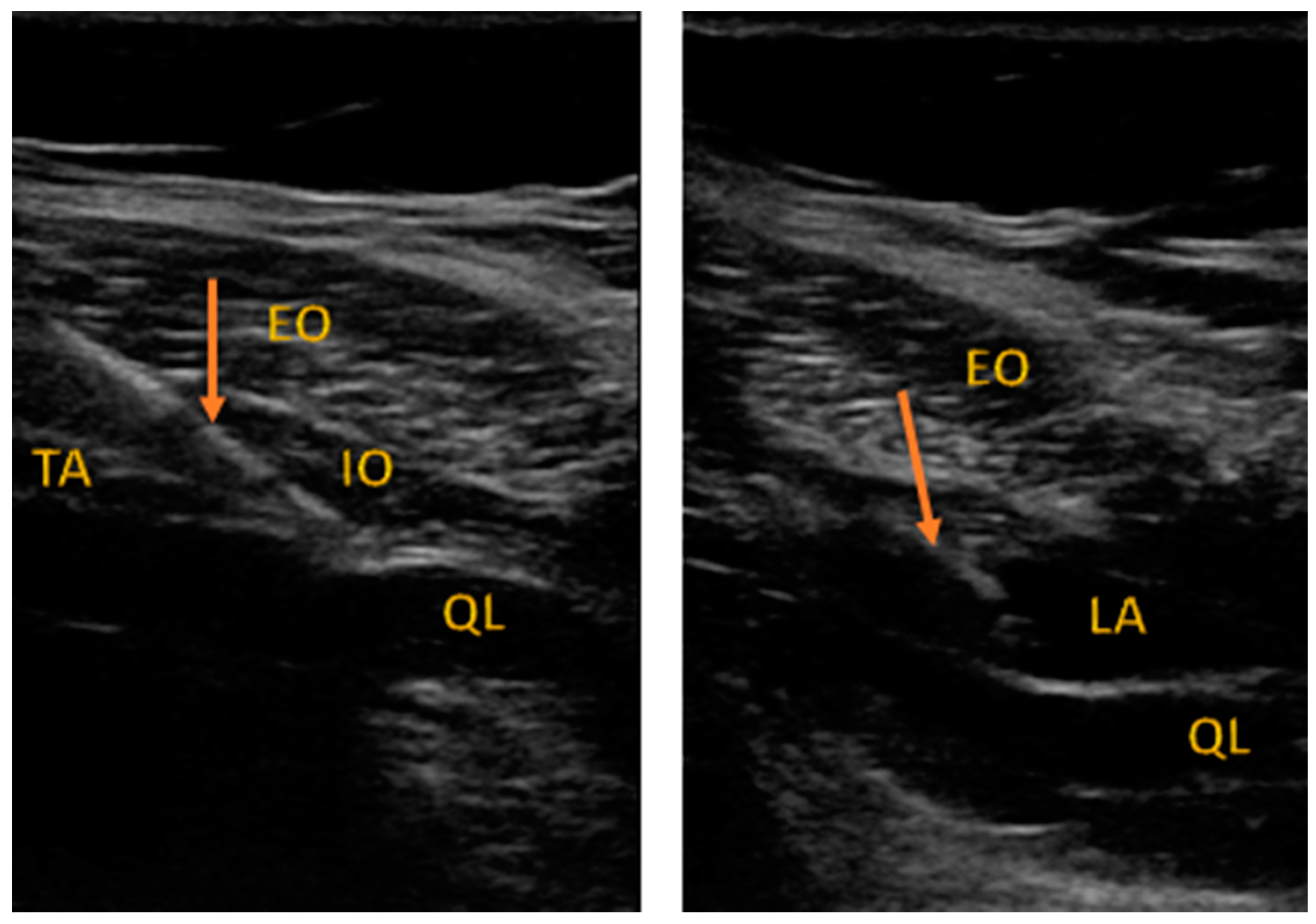
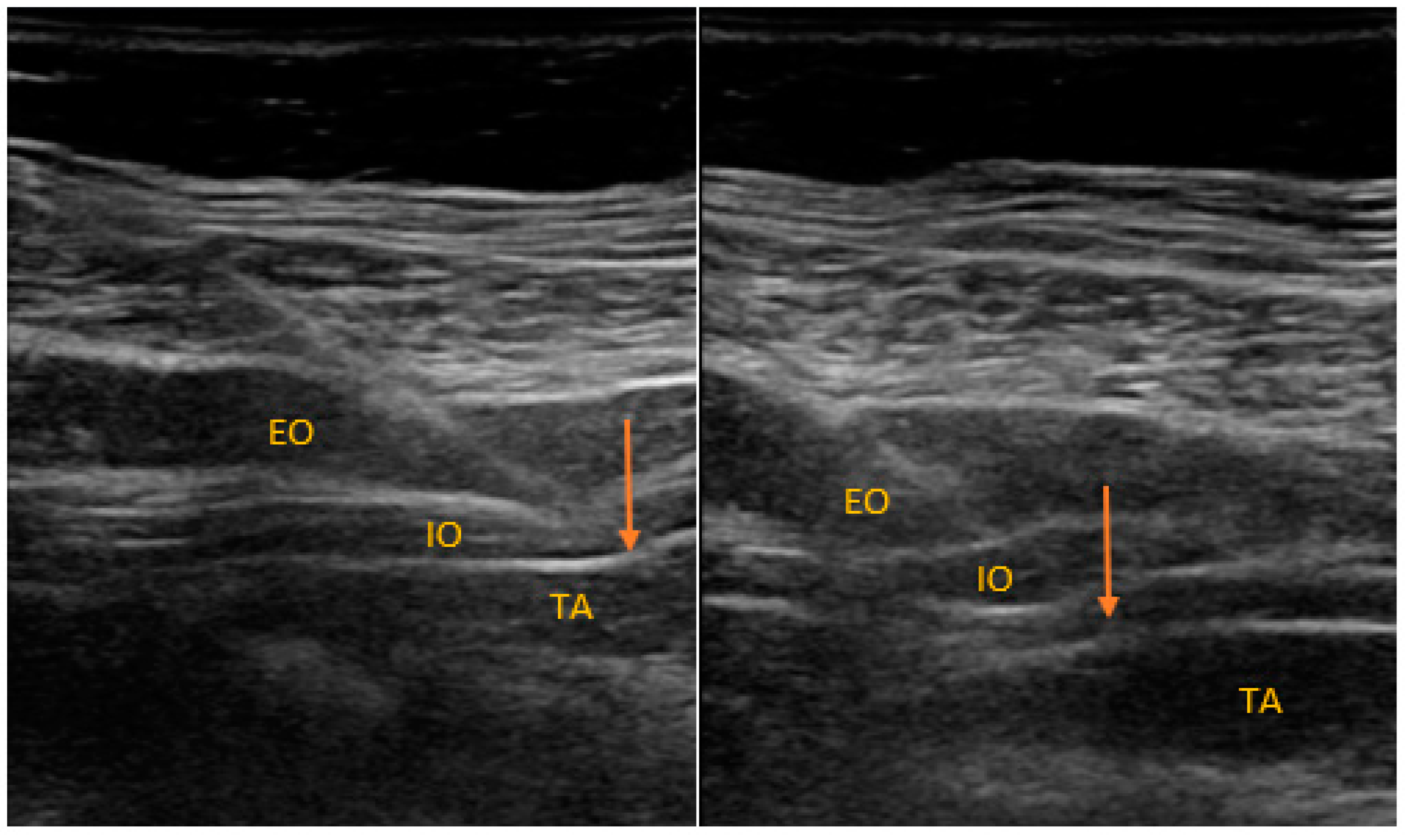
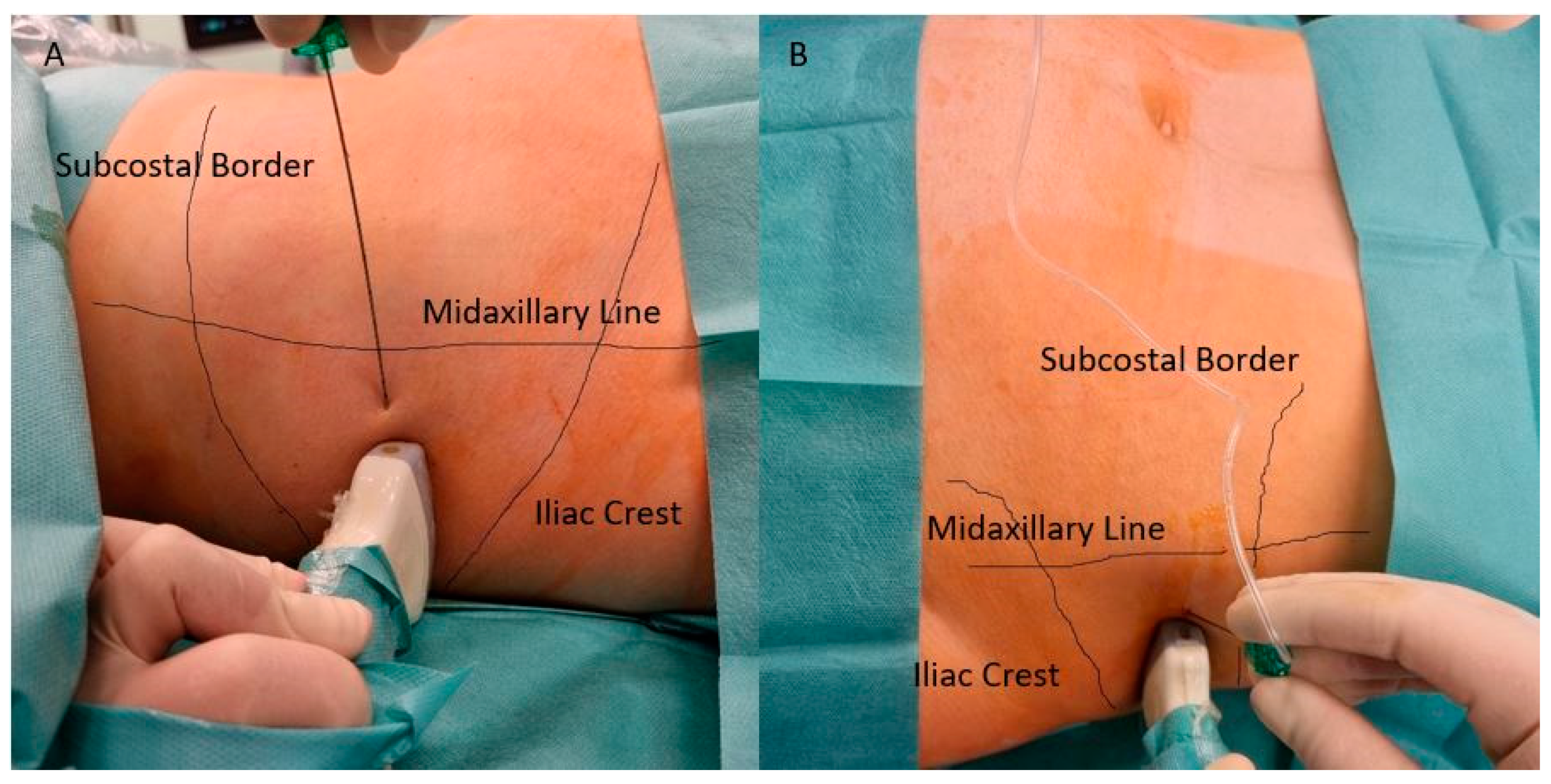
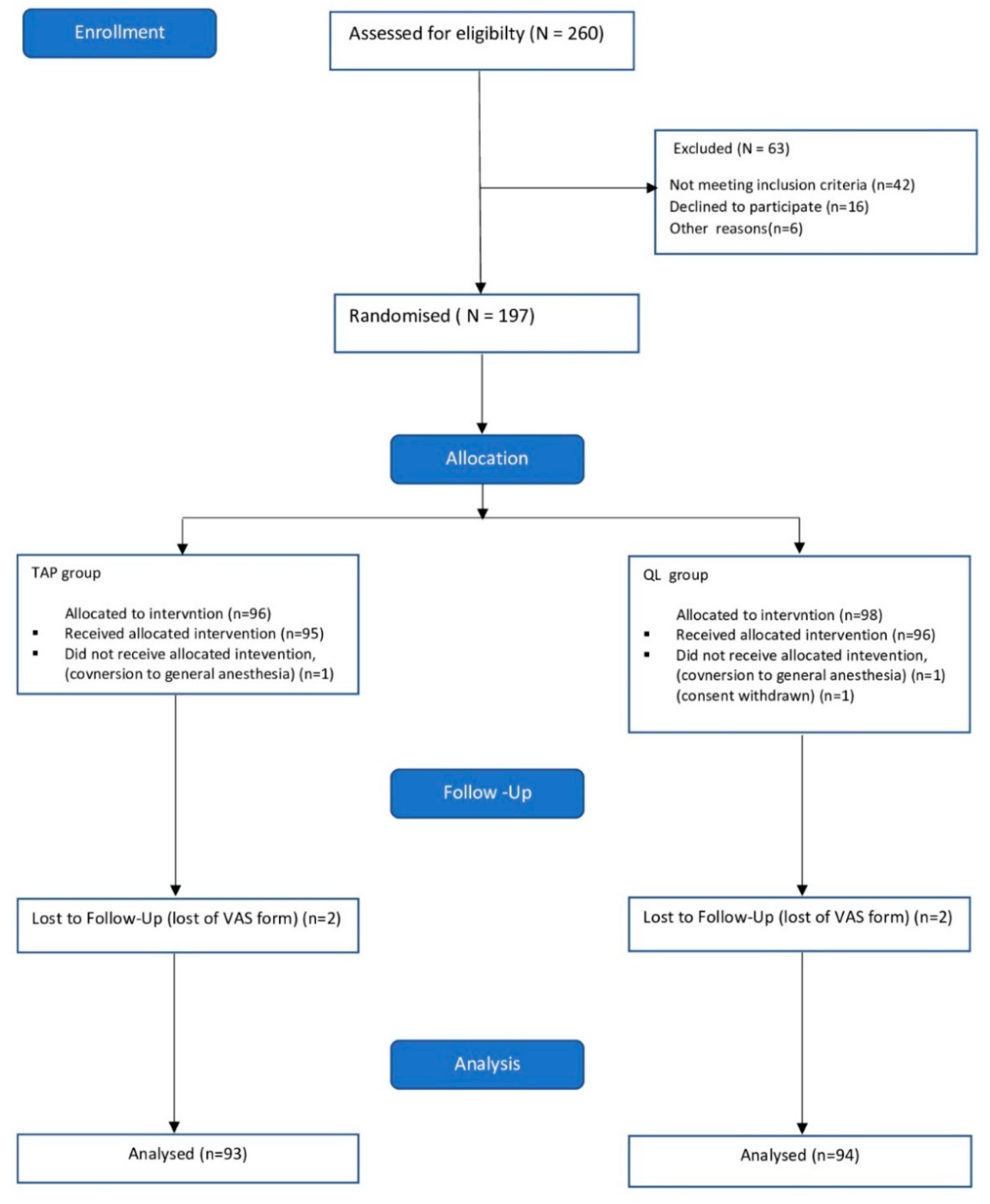
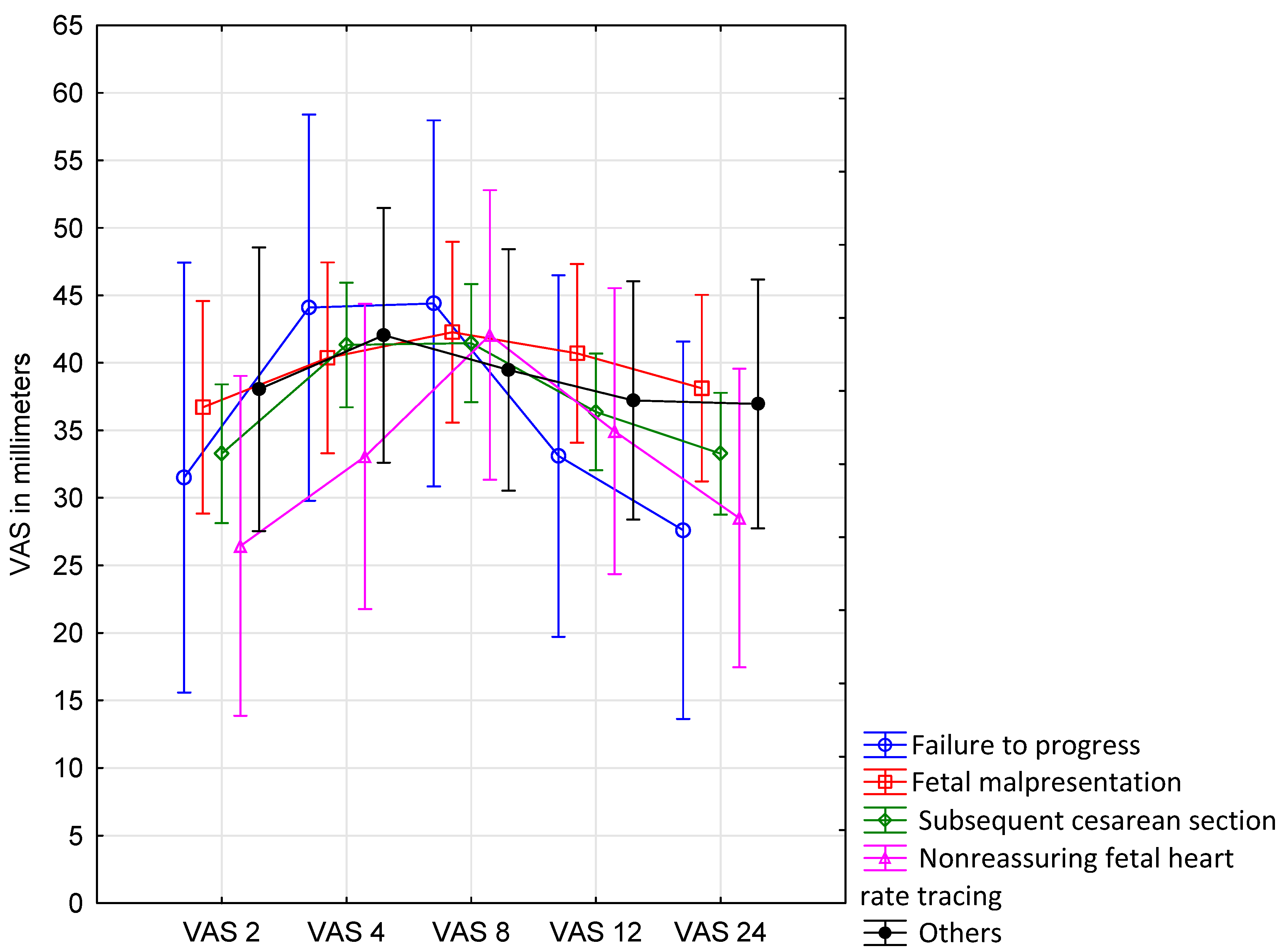
| Group | TAPB (n = 93) | QLB (n = 94) | p-Value |
|---|---|---|---|
| Age (years) | 31.48 (30.59–32.37) | 32.55 (31.63–33.47) | 0.67 |
| Weight (kg) | 80.39 (78.08–82.71) | 78.52 (76.47–80.57) | 0.71 |
| Height (m) | 1.67 (1.66–1.68) | 1.66 (1.65–1.68) | 0.91 |
| BMI (kg/m2) | 28.95 (28.17–29.74) | 28.64 (27.91–29.37) | 0.88 |
| Indication | Group | p-Value | |
|---|---|---|---|
| TAPB (n = 93) | QLB (n = 94) | ||
| Subsequent cesarean section | 45 | 53 | 0.27 |
| Fetal malpresentation | 21 | 25 | 0.52 |
| Nonreassuring fetal heart rate tracing | 9 | 7 | 0.59 |
| Failure to progress | 8 | 5 | 0.38 |
| Others | 10 | 4 | 0.09 |
| Mean VAS Results (CI) | |||
|---|---|---|---|
| Time After Surgery in Hours | TAPB | QLB | p-Value |
| 2 | 34.47 (29.26–39.69) | 33.20 (28.18–38.61) | 0.73 |
| 4 | 38.86 (34.20–43.53) | 42.42 (37.75–47.08) | 0.28 |
| 8 | 39.54 (35.14–43.93) | 43.67 (39.27–48.06) | 0.20 |
| 12 | 35.14 (30.78–39.50) | 39.12 (34.76–43.48) | 0.20 |
| 24 | 32.25 (27.67–36.83) | 35.91 (31.34–40.49) | 0.29 |
| Mean VAS | 36.05 (32.94–39.17) | 38.90 (35.79–42.02) | 0.64 |
| Antinociceptive Drug | Type of Regional Block | p-Value | |
|---|---|---|---|
| TAPB | QLB | ||
| Ketoprofen | 107.45 (91.21–123.69) mg | 102.22 (84.47–119.98) mg | 0.59 |
| Diclofenac | 22.34 (13.96–30.71) mg | 15.00 (6.45–23.56) mg | 0.45 |
| Paracetamol | 1117.02 (911.42–1322.62) mg | 1044.44 (853.69–1235.20) mg | 0.80 |
| Tramadol | 21.28 (11.96–30.59) mg | 28.89 (16.33–41.45) mg | 0.48 |
| Morphine | 4.02 (3.28–4.76) mg | 3.09 (2.36–3.83) mg | 0.085 |
| Indication | Type of Regional Block | p-Value | |
|---|---|---|---|
| TAPB | QLB | ||
| Subsequent cesarean section | 34.74 (30.18–39.30) | 39.08 (34.98–43.19) | 0.16 |
| Fetal malpresentation | 42.47 (34.75–50.19) | 37.01 (29.64–44.37) | 0.31 |
| Nonreassuring fetal heart rate tracing | 32.13 (24.23–40.04) | 34.11 (25.15–43.08) | 0.73 |
| Failure to progress | 30.04 (15.31–44.77) | 42.24 (27.51–56.97) | 0.21 |
| Others | 35.64 (27.87–43.41) | 47.07 (34.38–59.75) | 0.12 |
Publisher’s Note: MDPI stays neutral with regard to jurisdictional claims in published maps and institutional affiliations. |
© 2021 by the authors. Licensee MDPI, Basel, Switzerland. This article is an open access article distributed under the terms and conditions of the Creative Commons Attribution (CC BY) license (https://creativecommons.org/licenses/by/4.0/).
Share and Cite
Borys, M.; Potręć-Studzińska, B.; Kutnik, P.; Sysiak-Sławecka, J.; Rypulak, E.; Gęca, T.; Kwaśniewska, A.; Czuczwar, M.; Piwowarczyk, P. The Effectiveness of Transversus Abdominis Plane and Quadratus Lumborum Blocks in Acute Postoperative Pain Following Cesarean Section—A Randomized, Single-Blind, Controlled Trial. Int. J. Environ. Res. Public Health 2021, 18, 7034. https://doi.org/10.3390/ijerph18137034
Borys M, Potręć-Studzińska B, Kutnik P, Sysiak-Sławecka J, Rypulak E, Gęca T, Kwaśniewska A, Czuczwar M, Piwowarczyk P. The Effectiveness of Transversus Abdominis Plane and Quadratus Lumborum Blocks in Acute Postoperative Pain Following Cesarean Section—A Randomized, Single-Blind, Controlled Trial. International Journal of Environmental Research and Public Health. 2021; 18(13):7034. https://doi.org/10.3390/ijerph18137034
Chicago/Turabian StyleBorys, Michał, Beata Potręć-Studzińska, Paweł Kutnik, Justyna Sysiak-Sławecka, Elżbieta Rypulak, Tomasz Gęca, Anna Kwaśniewska, Mirosław Czuczwar, and Paweł Piwowarczyk. 2021. "The Effectiveness of Transversus Abdominis Plane and Quadratus Lumborum Blocks in Acute Postoperative Pain Following Cesarean Section—A Randomized, Single-Blind, Controlled Trial" International Journal of Environmental Research and Public Health 18, no. 13: 7034. https://doi.org/10.3390/ijerph18137034
APA StyleBorys, M., Potręć-Studzińska, B., Kutnik, P., Sysiak-Sławecka, J., Rypulak, E., Gęca, T., Kwaśniewska, A., Czuczwar, M., & Piwowarczyk, P. (2021). The Effectiveness of Transversus Abdominis Plane and Quadratus Lumborum Blocks in Acute Postoperative Pain Following Cesarean Section—A Randomized, Single-Blind, Controlled Trial. International Journal of Environmental Research and Public Health, 18(13), 7034. https://doi.org/10.3390/ijerph18137034







